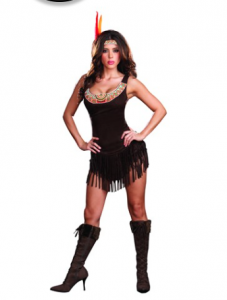When I was reading the accounts of Saartje Baartman and the way she was turned into a racialized and sexualized Other by Europeans, I thought back to Dr. Adrienne Keene’s lecture about the offensive images of Native American women that have existed for centuries. Like comments made by those who put Baartman on exhibit, early settlers in the Americas saw Native women as extremely sexualized and as theirs for the taking. In this way these women represented the land that needed to be dominated and controlled while reaping the benefits from it.
Although Baartman’s body itself became a display and an object, Native American women’s bodies have been collectively objectified in a process that turns real human beings into sexualized caricatures that can be sold for profit. From offensive Halloween costumes to images on food items to the trendy war bonnets worn at photoshoots and music festivals, the bodies and symbols of Native women been appropriated and commodified by a postcolonial structure that refuses to see Native women as contemporary and multi-dimensional.

Bulane-Hopa (2011) writes of the trauma of seeing oneself and one’s culture depicted by the former colonizer, made worse by a lack of control of choosing how to be portrayed. While Bulane-Hopa focuses on the medium of film, I see the depiction of Native Women fitting into such a framework as well. Both a sense of personhood as well as very real economic resources are lost when Native women are not given a say in how they will be represented.
The question of how this fits into repatriation is tricky. In the context of Native American women’s bodies, it is not a matter of hundreds of remains or several dozen funerary objects, but rather an entire collection of images that have already been proliferated through mainstream America. The first response I could think of was to stop using images and symbols of Native women—or to go a step further, all indigenous people—on items not produced or endorsed by Native women themselves. Yet this only halts a process that has been going on for a long time.
If repatriation is about giving back items and knowledge of spiritual importance, then perhaps advocating for the representation of Native women BY Native women could be a means of doing this. Giving due attention to the complicated and humanized depictions of Native women while also focusing on the alarming problems that many face (see additional readings) could be a way to restructure how Native women are ‘exhibited’ in our society.

Sources and Additional Readings
Image 1: http://www.spirithalloween.com/product/pocahottie-pow-wow-costume/
Image 2: https://www.youtube.com/watch?v=QbfOTpDbmyI
http://www.beyondbuckskin.com/2011/07/callaloo-parade-and-sexualization-of.html
